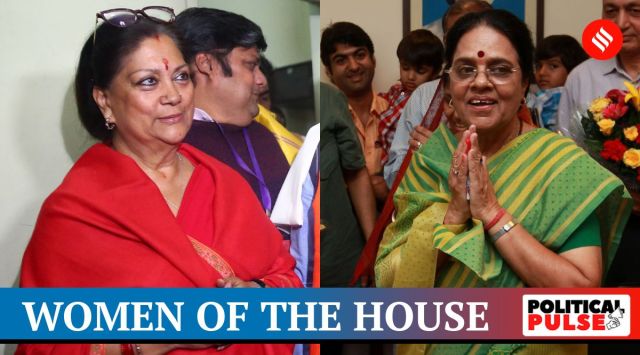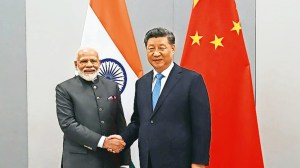Bhanwari Devi, Roop Kanwar, Vasundhara Raje: How they helped Rajasthan women find their feet
Women candidates first crossed 100 mark in the state in 2003, when Raje entered the picture as Rajasthan's first woman CM face. In 2018, 189 women contested; of 27 current women MLAs, many are long-time party workers
 Rajasthan BJP leader Vasundhara Raje; Congress' Girija Vyas. (Express photos)
Rajasthan BJP leader Vasundhara Raje; Congress' Girija Vyas. (Express photos) AFTER the constitution of the first Rajasthan Assembly in 1952, it took the state a good 50 years to have the number of contesting women cross the 100 mark in a state election.
This happened in the 2003 polls, when 118 women candidates were in the fray, up from 69 in 1998; fewer, however, won, 12, compared to 14 in 1998.
By the 2018 elections, there were 189 women in the fray, of whom 23 won; in the time since, four more women have been elected in bypolls.
The big jump between 1998 and 2003 can be attributed to two major factors. First, the Panchayati Raj Act, 1994, which extended one-third reservation to women in panchayati raj institutions. Additionally, as per sociologist Rajiv Gupta, various rights movements in Rajasthan beginning in the 1990s, such as the Right to Information, created awareness among women. “And immediately before that, there was the Bhanwari Devi case, the Sati case, etc,” he says.
Bhanwari Devi was gangraped by several upper caste men, leading ultimately to the Vishaka guidelines on sexual harassment at the work place. The Sati case involved Roop Kanwar “voluntarily” choosing to burn herself at the pyre of her husband, in Sikar’s Deorala.
Together, these developments led to political awareness among women, says Gupta, pointing out that this manifested in voting too. In the 2018 elections, a higher percentage of women (74.66) voted than men (73.49).
There was another development around the early 2000s that is seen to have left a lasting impact on Rajasthan politics. 2002-03 was the time BJP leader Vasundhara Raje moved from the Centre, where she was a Union minister, to Rajasthan, with the help of her mentor, former vice-president Bhairon Singh Shekhawat.
Political analyst Ashfaq Kayamakhani points out that 2003 was the first time since Independence that a major political party declared a woman as its chief minister candidate for Rajasthan; Raje went on to become the CM. Incidentally, the Congress had a tall woman leader in Girija Vyas as the PCC president then, but she remained sidelined in the presence of Ashok Gehlot.
Following the 2003 Assembly elections, both the BJP and Congress fielded even more women in the 2008 polls, with the total crossing the 150 mark.
Just before the 2008 polls, women’s representation received another push when Raje as CM brought in an amendment to increase their quota in local bodies from one-third or 33% to 50%.
In the 2008 Assembly elections, 28 women won – nearly double their previous high of 16 in 1985. While the Congress won, and Gehlot replaced Raje as CM, the greater representation for women continued.
In the 2013 elections, when Raje again took over as CM, 166 women contested, out of which 28 won.
In 2018, 27 of the 195 candidates fielded by the Congress were women, while 23 of the 200 in the BJP list were women.
Of the current 27 women MLAs in Rajasthan, 15 belong to the Congress, 10 to the BJP, while 1 to the RLP, while 1 is an Independent.
Of them, many are long-time party workers. For example, Anita Bhadel (Ajmer South) and Suryakanta Vyas (Soorsagar) come from an RSS background and have been longtime BJP workers. Indira Meena (Bamanwas) started out with the Youth Congress while Minister Mamta Bhupesh (Sikrai) started with the NSUI.
The Congress’s Shakuntala Rawat (Bansur) and Manisha Panwar (Jodhpur) as well as the BJP’s Chandrakanta Meghwal (Keshoraipatan), too have been long-term party workers.
Then there is Ramila Khadiya. Denied a ticket by the Congress, she contested as an Independent from Kushalgarh and won, becoming the lone Independent woman MLA in the current Assembly.
Among those whose rise is linked to their family affiliations is Raje, who belongs to the Gwalior royal family and married into Dholpur royalty. Kalpana Devi, a member of the erstwhile Kota royal family and the wife of former Congress MP Ijyaraj Singh, is the MLA from Ladpura in Kota, while Siddhi Kumari, of the erstwhile Bikaner royal family, is the MLA from Bikaner East.
Divya Maderna (Osian MLA) hails from the politically influential Maderna clan, while Indira Devi (Merta) is seen to have got a ticket as RLP supremo Hanuman Beniwal considers her his sister. While Shafia Zubair, MLA from Ramgarh in Alwar, is the wife of Congress leader Zubair Khan, she is an active party worker.
A few were elected riding sympathy waves in bypolls. Deepti Kiran Maheshwari (Rajsamand) is the daughter of late BJP Minister Kiran Maheshwari, Gayatri Devi Trivedi (Sahara) is the widow of former MLA Kailash Chandra Trivedi, and Preeti Shaktawat (Vallabhnagar) is the widow of MLA Gajendra Singh Shaktawat.

Meena Kanwar (Shergarh) was given a ticket by the Congress and won after her husband Ummed Singh lost twice.
Among women MLAs with professional alternative careers, the only prominent name is that of Krishna Poonia, a former Olympian.
Rajasthan Minister for Women and Child Welfare Mamta Bhupesh says: “When women contest against men, it is not a level playing field. For example in Uttar Pradesh, our leader Priyanka (Gandhi) ji tried for women to get 40% party tickets. But the women contested against dhan-bal and baahu-bal (money and muscle power).”
In UP, the Congress had fielded 155 women for the 399 (out of 403) seats it contested. It won only two seats, one of them by a woman candidate.
Crediting the Congress for the recent women’s reservation Act, Bhupesh adds: “Rajiv Gandhi’s dream resulted in 50% reservation for women in local bodies. Sonia Gandhi wanted to reserve one-third of seats for women in the Lok Sabha and Assemblies 15 years ago.”
Six-term BJP MLA Suryakanta Vyas, 85, agrees that “more women should be brought forward”. “I have been an MLA since 1990 and parties give tickets, but not as much as they should.” Praising Prime Minister Narendra Modi for the Nari Shakti Vandan Adhiniyam, she says that even if the Act can’t be implemented right away, “women should be given a priority” in the coming elections.
Of the states which figure among the top six in Assembly representation for women, Rajasthan is the first to see an election after the passage of the women’s reservation Act.
Photos




- 011 day ago
- 021 day ago
- 031 day ago
- 041 day ago
- 051 day ago


























